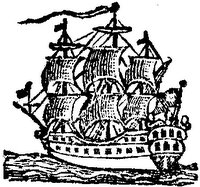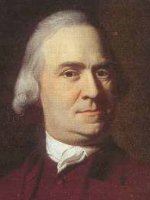British-American Prisoner Exchange
I promised to write about Ann Molineux’s marriage today, but then I realized I’d already planned to discuss an event from 1775 noted in selectman Timothy Newell’s diary:
6th [June]. Mr. John Peck, Mr. Frost, Mr. Brewer and sundry others discharged from on board the Admiral in exchange of prisoners, viz Major Dunbar, Capt Gould and a number of wounded soldiers.This was the first negotiated exchange of prisoners in the Revolutionary War, I believe. [ADDENDUM: There was an earlier exchange of one wounded British officer for one American on 28 May 1775.] Newell didn’t have all the prisoners’ names, and one of the names he listed (Gould) was an error. Here’s a very detailed report on the day from the Patriot newspaper nearest the scene, the 9 June Essex Gazette:
Tuesday last being the day agreed on for the exchange of prisoners, between 12 and 1 o’clock, Dr. [Joseph] Warren and Brigadier General [Israel] Putnam, in a phaeton, together with Major Dunbar, and Lieut. Hamilton of the 64th on horse-back; Lieut. Potter, of the marines, in a chaise; John Hilton of the 47th, Alexander Campbell of the 4th, John Tyne, Samuel Marcy, Thomas Parry, and Thomas Sharp, of the marines, wounded men, in two carts; the whole escorted by the Weathersfield company, under the command of Capt. Chester, entered the town of Charlestown, and marching slowing [sic] thro’ it, halted at the ferry, where, upon a signal being given, Major [Thomas] Moncrief landed from the Lively, in order to receive the prisoners, and see his old friend, General Putnam:—The map above, courtesy of the National Park Service, shows the Charlestown peninsula in 1775. It centers on the Bunker Hill battlefield, of course. The prisoner exchange probably took place in the settled part of town near the bottom, where the ferry landed and gentlemen could sit down for a good meal.
Their meeting was truly cordial and affectionate. The wounded privates were soon sent on board the Lively; but Major Moncrief, and the other officers, returned with Gen. Putnam and Dr. Warren, to the house of Dr. [Isaac] Foster, where an entertainment was provided for them.
About 3 o’clock, a signal was made by the Lively, that they were ready to deliver up our prisoners; upon which, Gen. Putnam and Major Moncrief went to the ferry, where they received Messirs. John Peck, James Hews, James Brewer, and Daniel Preston, of Boston; Messirs. Samuel Frost and Seth Russell, of Cambridge; Mr. Joseph Bell, of Danvers; Mr. Elijah Seaver, of Roxbury, and Caesar Augustus, a negro servant of Mr. Tileston, of Dorchester, who were conducted to the house of Capt. Foster, and there refreshed; after which, the General and Major returned to their company, and spent an hour or two in a very agreeable manner.
Between 5 and 6 o’clock Major Moncrief, with the officers that had been delivered to him, were conducted to the ferry, where the Lively’s barge received them; after which, General Putnam, with the prisoners who had been delivered to him, &c. returned to Cambridge, escorted in the same manner as before.
The whole was conducted with the utmost decency and good humor; and the Weathersfield company did honor to themselves, their officers, and their country. The regular officers expressed themselves as highly pleased; those who had been prisoners politely acknowledged the genteel, kind treatment they had received from their captors; the privates, who were all wounded men, expressed in the strongest terms, their grateful sense of the tenderness which had been shown them in their miserable situation; some of them could only do it by their tears. It would have been to the honour of the British arms, if the prisoners taken from us could with justice make the same acknowledgment.
COMING UP: Who were all those guys, and how had they become prisoners?









